Abstract
Staphylococcal enterotoxins (SEs) are unique bacterial toxins that cause gastrointestinal toxicity as well as superantigenic activity. Since systemic administration of SEs induces superantigenic activity leading to toxic shock syndrome that may mimic enterotoxic activity of SEs such as vomiting and diarrhea, oral administration of SEs in the monkey feeding assay is considered as a standard method to evaluate emetic activity of SEs. This chapter summarizes and discusses practical considerations of the monkey feeding assay used in studies characterizing classical and newly identified SEs.
Access this chapter
Tax calculation will be finalised at checkout
Purchases are for personal use only
References
Dack GM, Cary WE, Woolper O, Wiggers H (1930) An outbreak of food poisoning proved to be due to a yellow hemolytic Staphylococcus. Can J Microbiol 4:167–175
Bergdoll MS, Surgalla MJ, Dack GM (1959) Staphylococcal enterotoxin. Identification of a specific precipitating antibody with enterotoxin-neutralizing property. J Immunol 83:334–338
Casman EP (1960) Further serological studies of staphylococcal enterotoxin. J Bacteriol 79:849–856
Munson SH, Tremaine MT, Betley MJ, Welch RA (1998) Identification and characterization of staphylococcal enterotoxin types G and I from Staphylococcus aureus. Infect Immun 66:3337–3348
Ono HK, Omoe K, Imanishi K, Iwakabe Y, Hu DL, Kato H, Saito N, Nakane A, Uchiyama T, Shinagawa K (2008) Identification and characterization of two novel staphylococcal enterotoxins, types S and T. Infect Immun 76:4999–5005. doi:10.1128/iai.00045-08
Su YC, Wong AC (1995) Identification and purification of a new staphylococcal enterotoxin, H. Appl Environ Microbiol 61:1438–1443
Spaulding AR, Salgado-Pabon W, Kohler PL, Horswill AR, Leung DY, Schlievert PM (2013) Staphylococcal and streptococcal superantigen exotoxins. Clin Microbiol Rev 26:422–447. doi:10.1128/cmr.00104-12
Lina G, Bohach GA, Nair SP, Hiramatsu K, Jouvin-Marche E, Mariuzza R (2004) Standard nomenclature for the superantigens expressed by Staphylococcus. J Infect Dis 189:2334–2336. doi:10.1086/420852
Bergdoll MS (1988) Monkey feeding test for staphylococcal enterotoxin. Methods Enzymol 165:324–333
Omoe K, Hu DL, Ono HK, Shimizu S, Takahashi-Omoe H, Nakane A, Uchiyama T, Shinagawa K, Imanishi K (2013) Emetic potentials of newly identified staphylococcal enterotoxin-like toxins. Infect Immun 81:3627–3631. doi:10.1128/iai.00550-13
Sugiyama H, Hayama T (1965) Abdominal viscera as site of emetic action for staphylococcal enterotoxin in the monkey. J Infect Dis 115:330–336
Alber G, Scheuber PH, Reck B, Sailer-Kramer B, Hartmann A, Hammer DK (1989) Role of substance P in immediate-type skin reactions induced by staphylococcal enterotoxin B in unsensitized monkeys. J Allergy Clin Immunol 84:880–885
Jett M, Neill R, Welch C, Boyle T, Bernton E, Hoover D, Lowell G, Hunt RE, Chatterjee S, Gemski P (1994) Identification of staphylococcal enterotoxin B sequences important for induction of lymphocyte proliferation by using synthetic peptide fragments of the toxin. Infect Immun 62:3408–3415
Alber G, Hammer DK, Fleischer B (1990) Relationship between enterotoxic- and T lymphocyte-stimulating activity of staphylococcal enterotoxin B. J Immunol 144:4501–4506
Harris TO, Betley MJ (1995) Biological activities of staphylococcal enterotoxin type A mutants with N-terminal substitutions. Infect Immun 63:2133–2140
Hovde CJ, Marr JC, Hoffmann ML, Hackett SP, Chi YI, Crum KK, Stevens DL, Stauffacher CV, Bohach GA (1994) Investigation of the role of the disulphide bond in the activity and structure of staphylococcal enterotoxin C1. Mol Microbiol 13:897–909
van Gessel YA, Mani S, Bi S, Hammamieh R, Shupp JW, Das R, Coleman GD, Jett M (2004) Functional piglet model for the clinical syndrome and postmortem findings induced by staphylococcal enterotoxin B. Exp Biol Med 229:1061–1071
Hu DL, Omoe K, Saleh MH, Ono K, Sugii S, Nakane A, Shinagawa K (2001) Analysis of the epitopes on staphylococcal enterotoxin A responsible for emetic activity. J Vet Med Sci 63:237–241
Kocandrle V, Houttuin E, Prohaska JV (1966) Acute hemodynamic and gastrointestinal changes produced by staphylococcal exotoxin and enterotoxin in dogs. J Surg Res 6:50–57
Onogawa T (2002) Staphylococcal alpha-toxin synergistically enhances inflammation caused by bacterial components. FEMS Immunol Med Microbiol 33:15–21
Holzinger D, Gieldon L, Mysore V, Nippe N, Taxman DJ, Duncan JA, Broglie PM, Marketon K, Austermann J, Vogl T, Foell D, Niemann S, Peters G, Roth J, Loffler B (2012) Staphylococcus aureus Panton-Valentine leukocidin induces an inflammatory response in human phagocytes via the NLRP3 inflammasome. J Leukoc Biol 92:1069–1081. doi:10.1189/jlb.0112014
Kulhankova K, King J, Salgado-Pabon W (2014) Staphylococcal toxic shock syndrome: superantigen-mediated enhancement of endotoxin shock and adaptive immune suppression. Immunol Res 59:182–187. doi:10.1007/s12026-014-8538-8
Melling J (1977) Use of anaesthesia with ketamine HCl in assessing the emetic activity of staphylococcal enterotoxin B in the rhesus monkey (Macacca mulatta). Br J Exp Pathol 58:40–41
Adesiyun AA, Tatini SR (1982) Incidence of ketamine-induced emesis in cynomologus monkeys (Macaca fascicularis) used for staphylococcal enterotoxin bioassay. Br J Exp Pathol 63:330–335
Author information
Authors and Affiliations
Corresponding author
Editor information
Editors and Affiliations
Rights and permissions
Copyright information
© 2016 Springer Science+Business Media New York
About this protocol
Cite this protocol
Seo, K.S. (2016). Monkey Feeding Assay for Testing Emetic Activity of Staphylococcal Enterotoxin. In: Brosnahan, A. (eds) Superantigens. Methods in Molecular Biology, vol 1396. Humana Press, New York, NY. https://doi.org/10.1007/978-1-4939-3344-0_11
Download citation
DOI: https://doi.org/10.1007/978-1-4939-3344-0_11
Published:
Publisher Name: Humana Press, New York, NY
Print ISBN: 978-1-4939-3342-6
Online ISBN: 978-1-4939-3344-0
eBook Packages: Springer Protocols

